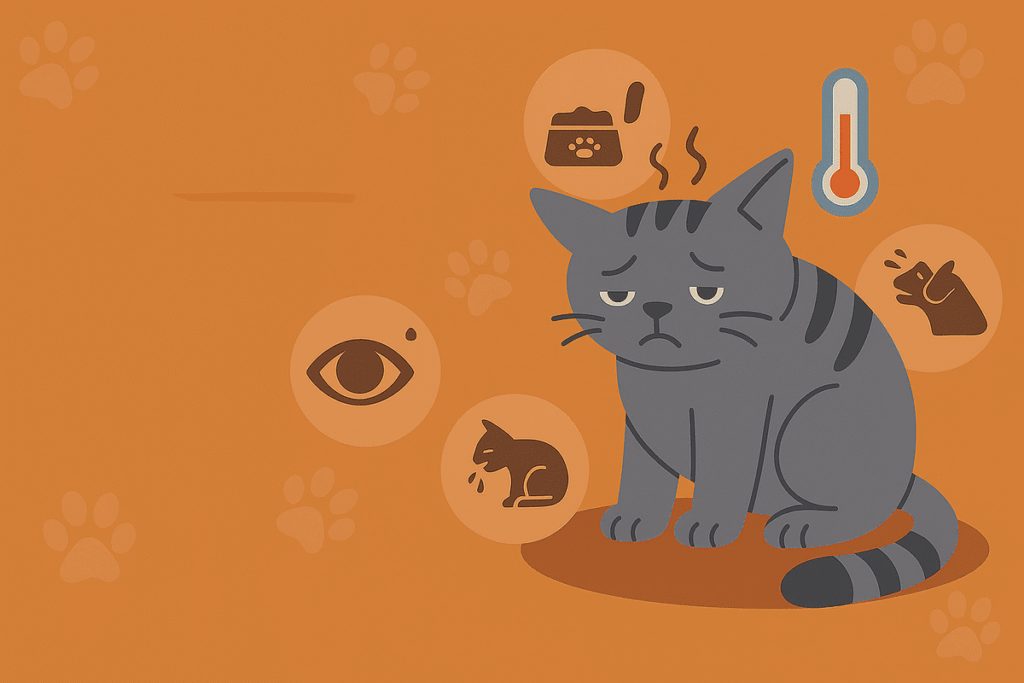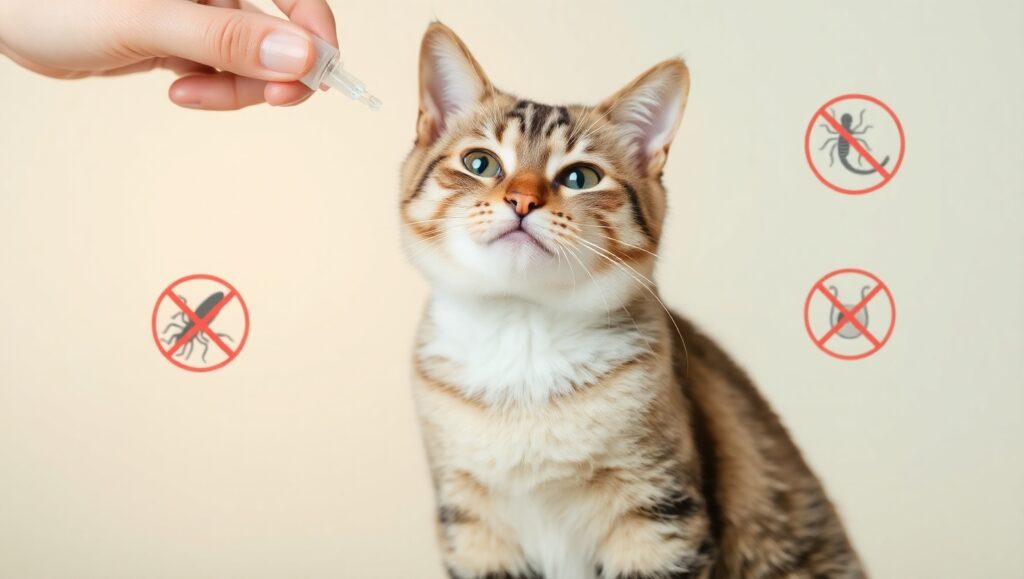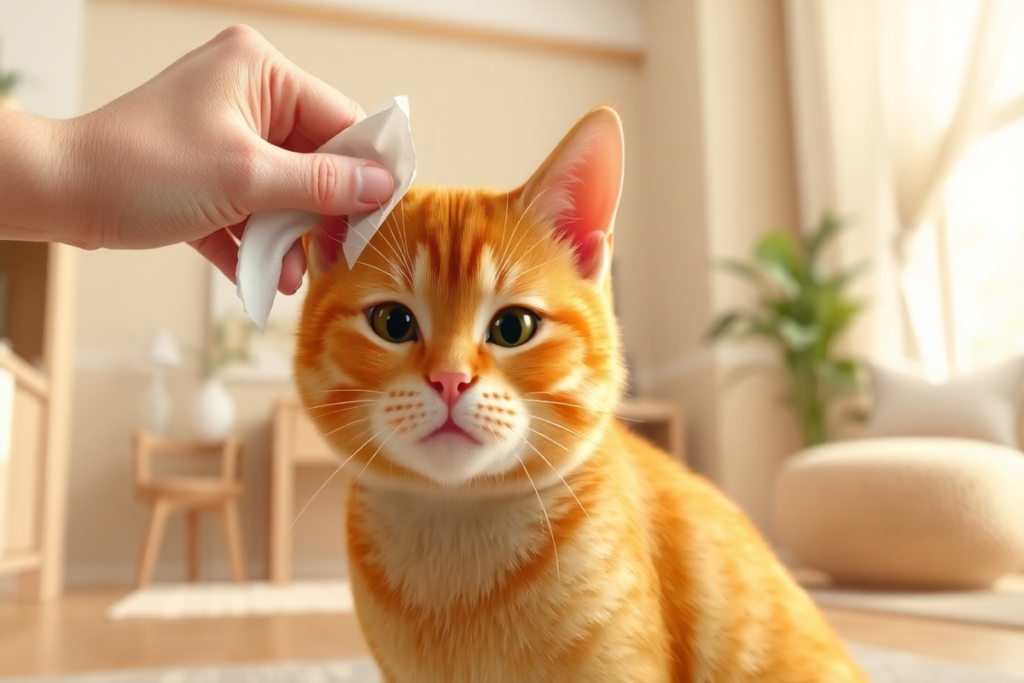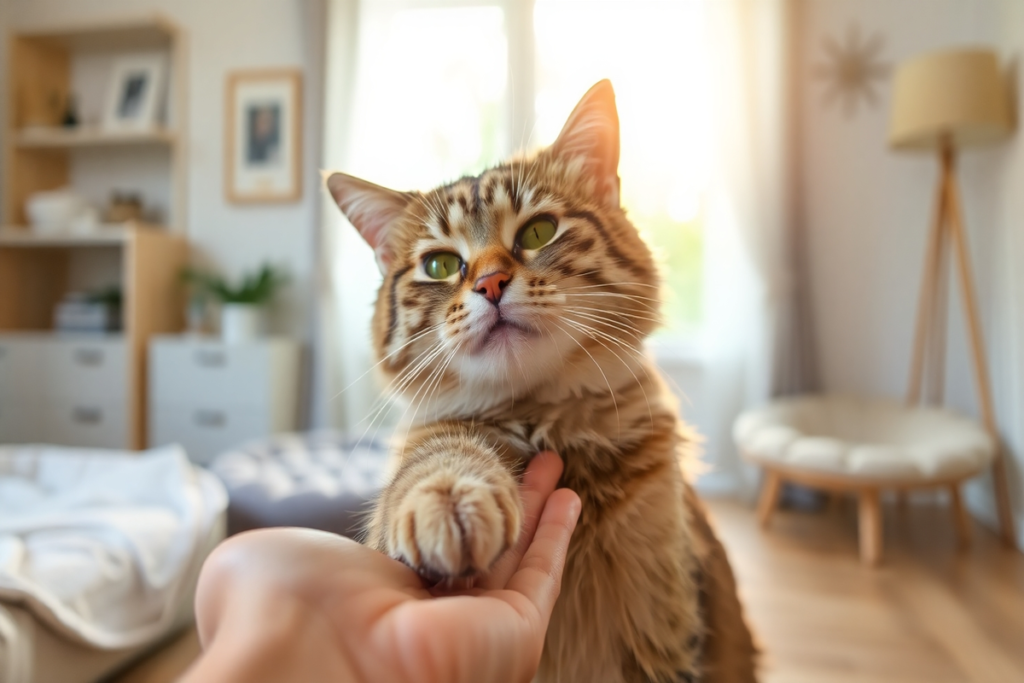Kneading is a common behavior observed in cats, where they push and pull their paws in and out on soft surfaces, such as blankets, cushions, and laps.
This behavior is also called “making biscuits.” Kneading is an instinctual behavior that starts in kittenhood. It serves multiple purposes, like comforting, bonding, marking territory, and reducing stress.
I can’t forget the first time when I saw my cat use her claws on my sweater. She looked absorbed entirely, eyes half closed, purring, completely zoned out. It made me wonder why cats knead. Is it stress, love, or something else?
In this article, I will go through all the reasons behind this interesting cat behavior when cats knead and what it means for your cat’s feelings. Whether you’re a first-time cat owner or a long-time cat lover, understanding kneading can help you bond even more with your cat.
What Is Cat Kneading?
Kneading is one of those delightful and cute cat behaviors that always makes me smile.
It is the rhythmic action of a cat walking their front paws, sometimes even all fours, into a soft object like a blanket, pillow, or lap.
It is referred to as “making biscuits” and “milk treading,” and it is typically an indication your cat is feeling safe, relaxed, and happy.
Kneading varies among cats, using claws, purring, or even drooling or staring off into space. Kneading begins in baby kittens as a way to stimulate milk production from their mother, and many cats continue the behavior into adulthood.
Let’s look at why cats knead and what it conveys about the emotional experience of your feline friend.
Understanding the Surprising Reasons Cats Knead
Don’t dismiss it as just another cute kitty quirk; let’s have a look to see why kneading is essential and what your cat is trying to say to you with those little paws pushes.
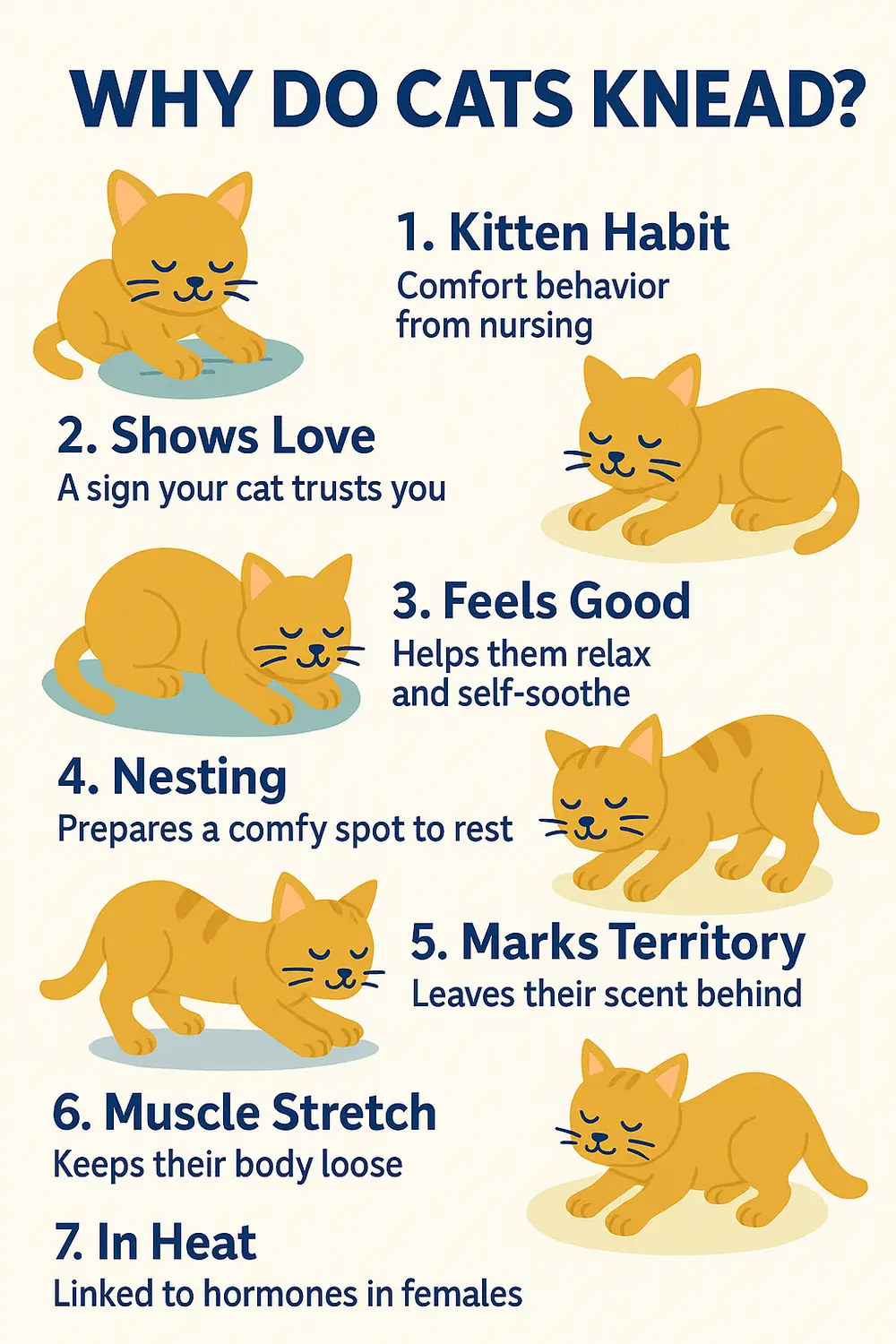
Instinct from Kittenhood
One of the biggest reasons that cats knead is that it begins at birth.
Young kittens are born with the instinct to knead their mother’s stomach to stimulate milk flow while nursing. That pleasant sensation is then “memorized,” and many domestic cats carry that into adulthood as a signal of feeling accepted and cared for.
Even as adults, cats associate this movement with warmth, safety, and an association with positive bonds with their mothers. So when they knead a soft object, it almost feels like they are going back in time to those days as cozy kittens.
According to Purina, kneading is a leftover behavior from when kittens would rhythmically knead their mother’s belly to stimulate the flow of her milk.
Affection Toward Owners
When my cat jumps into my lap and begins kneading, I like to think of it as a lovely compliment. To me, it’s the cat’s way of saying, “I trust you.”
The kneading is just one of the most obvious signs of affection. Your cat is emotionally secure around you, almost like they are bonding in the same way they did with their mom.
You may see that they only knead certain people, too, especially their favorite person. If you’re getting these biscuit paws, I would take it as a stamp of approval.
Kneading is one of the apparent signs your cat loves you and feels connected to you on an emotional level – it’s truly a bonding experience.
Comfort and Relaxation
Kneading isn’t just adorable; it’s soothing for cats. Kneading will generally release relaxing endorphins, which help them settle down and feel relaxed.
You may also even see your cat purring or drooling while kneading, which demonstrates just how soothing it is for them and creates a sense of contentment.
Kneading for cats is also a form of self-soothing. Just like a person may fidget or hum when they feel calm, cats knead to ground their feelings and feel a moment of calmness.
Making a Nest
Kneading is also a behavior related to nesting, one your cat learned from its wild ancestors, who would knead to pat down the long grass or leaves into a comfortable, safe resting place before lying down.
When your kneading cat kneads the cushion or blanket, they are simply making their perfect little bed.
Cats knead instinctively as a way to exert some control over their environment. Fluffing up their resting area helps them feel more comfortable, and in their mind, they have just made the coziest nap location in the house – one of their favorite sleeping spots.
Marking Territory
When your cat kneads, it’s not just a cuddle cue; it’s a way for your cat to communicate, “This is mine.”
The pads on their paws have pheromone glands that release pheromones when they knead. So even if it’s your lap, bed, or sofa, they are marking you and your possessions as theirs in the most gentle way.
It is part of a cat’s natural instinct to claim and protect what they love. So, the next time your cat kneads on you, remember that they are indicating they are marking you as part of their inner circle as territory and heart.
WebMD explains that “kneading” also allows cats to mark territory in the form of a scent in the paws, therefore leaving behind a comforting smell that claims the cat’s space.
Stretching Muscles
Kneading, much like we do when we stretch our bodies upon waking, allows cats to stretch their paws, legs, and spine.
Kneading is a gentle, instinctual form of feline yoga that keeps their muscles flexible and keeps their joints feeling good, especially after a long catnap.
Stretching while kneading is a great benefit for older cats who are just trying to remain flexible and mobile. Kneading is another way to be relaxed and body-aware.
Going into Heat (in Female Cats)
If your female cat is unspayed and all of a sudden is kneading more than usual, she may be entering heat.
In addition to kneading, she might be loud, rolling, and more loving than usual. Spaying typically decreases these signs and contributes to her overall health in the long run.
Kneading during heat hop could also draw in male cats and overall make her scent more noticeable. If it becomes frequent, a vet visit could help you to make the proper care decision.
Why Do Some Cats Knead More Than Others?
Some cats will knead more frequently than others, and this is often perfectly normal. If your cat is constantly pawing at blankets, your lap, or even the couch, this is likely their way of showing and receiving affection and being a relaxed kitty.
Some breeds of cats and more emotionally expressive cats tend to knead more often.
Frequent kneading can be indicative of a strong relationship between you and your cat. It may help cats to feel relaxed and secure, particularly if they are in a calm environment or are recovering from stress.
This commonly found behavior is likely a continuation of their kitten instincts that remind them of the comfort of kneading your lap as a happy kitten.
When Does Kneading Become a Problem?
As responsible pet owners, it is crucial to know the difference between a relaxed and happy kitty and a cat that is trying to self-soothe or communicate distress. Observing your cat’s behavior and daily routine and knowing these red flags early will help you take appropriate actions to care for your kitty’s well-being.
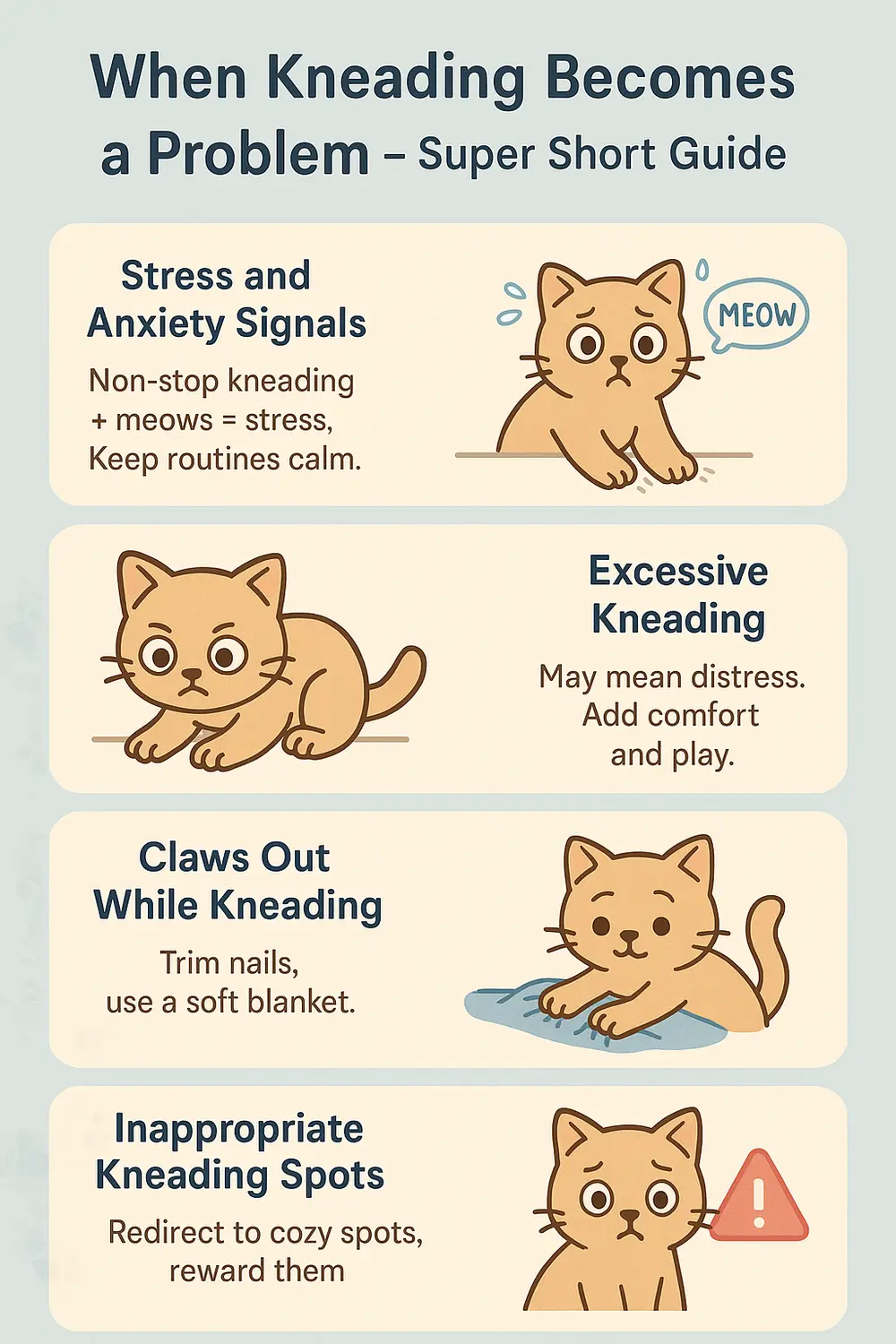
When Kneading Becomes Excessive
I love it when my cat curls up and starts kneading; it’s one of those precious moments that melt my heart and remind me just how much she trusts me. I’ve noticed as well, however, that sometimes, this innocent behavior can be concerning.
When excessive kneading occurs too frequently or too earnestly, for example, it’s disturbing your cat’s sleeping, eating, or playing, then there may be something more serious at play. Determining why your cat may be meowing excessively can give you possible reasons for possible stress triggers.
Kneading That Signals Stress or Anxiety
If your cat constantly appears restless, lets out a loud meow, and loses its appetite, your cat could be saying, “I’m stressed” or “I’m anxious.” Cats can show anxious behavior from changes at home, a new pet, loud noises, or boredom. Take notice of what is going on in the environment and always comfort, stimulate, and give some level of consistency to help your cat feel safe.
Kneading With Claws Out Can Cause Injuries
Being punctured by small claws while trying to cuddle up is not comfortable at all! Some cats knead with sharp claws extended, and while their intention is never to hurt you, they can leave scratches on your skin or, even worse, snag your favorite blanket.
I keep my cat’s nails trimmed and only put a soft, thick blanket over my lap before she settles in. Alternatively, you can provide your cat with a special “kneading corner” with thick, comfortable bedding materials, which they will love!
Kneading in Inconvenient Places
Cats don’t always pick the right things to knead. If it’s on your laptop, your fine silk cushion, or your lap during a Zoom meeting, this behavior may be annoying. The good thing, though?
With gentle redirection, cats can learn acceptable kneading places. I have trained mine to curl up in her favorite plush blanket or fleece throw by giving her a treat when she lies in the right place.
Knowing When to See the Vet
Kneading is generally harmless and cute. However, if your cat’s body language has suddenly changed, kneading is excessive, or combined with other concerning behaviors such as hiding, weight loss, or aggression, have a chat with your vet or Animal Hospital. Make sure there are no underlying medical problems right away, and keep your pet happy and healthy.
How to Stop Painful Cat Kneading Without Hurting Their Feelings
Kneading is cute unless your cat’s claws are sinking into your lap! Although your cat means it as affection, those little paws sometimes feel more like little needles. There are easy ways to protect yourself and still allow for your cat’s affection.
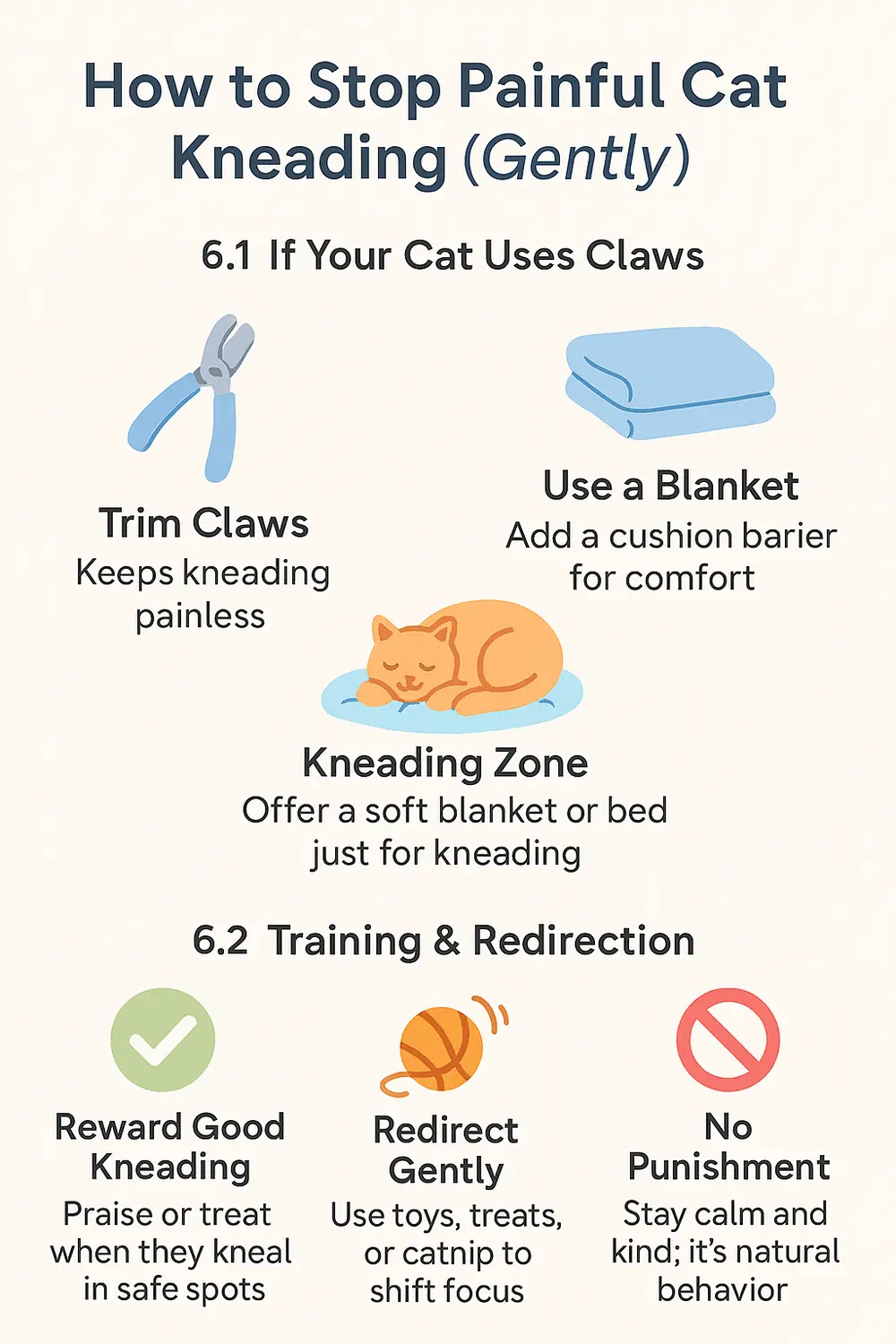
If Your Cat Uses Claws
Regularly Trim Their Claws
If you have a kitty who kneads with claws engaged (and it feels like a cactus is giving you a tiny massage, don’t worry; you are not alone. One of the best things I have discovered is to trim their claws regularly. Trimming their claws regularly can help reduce how sharp they are and lessen any possible accidents by scratching you during cuddle time.
To minimize a potential scratch when a cat is kneading, the ASPCA recommends that regular nail trimming be a part of your grooming routine.
Use an Affection Blanket or Cushion Barrier
I also have a thick blanket or cushion that I keep close by whenever my cat climbs into my lap. The blanket or cushion acts as a soft barrier, and it makes kneading feel more pleasant instead of painful.
Create a Designated Kneading Zone
The last tip that has worked very well for me is to create a designated kneading zone. I use a soft fleece blanket or padded cat bed. It allows my furry friend to make as many biscuits as she wants without using my legs as the dough.
Training and Redirection
Reward Positive Kneading Behavior
When your cat kneads in accepted places, like their bed or blankets, gently praise, reward, or give them a soft pet. Positive reinforcement helps a cat associate that place with comfort and acceptance, encouraging them to return next time.
If you are new to cat behavior, these essential cat care tips can help you manage kneading or other habits positively and productively.
Divert their Attention
If your cat is kneading in an undesirable location (like the lap, with claws fully extended), attempt to divert their attention gently. Use a favorite toy, a sprinkle of catnip, or even a treat to redirect their attention while still keeping them entertained and loved.
Do not punish
Never scold or push your cat away when they knead. Punishment can increase stress and harm your bond. Kneading is a natural and instinctual comfort behavior, and your goal is to redirect, not eliminate, the behavior.
Can You Stop a Cat from Kneading?
Not entirely, and let’s be honest, you shouldn’t want to. Kneading is something that most cats enjoy because it is natural for them and comforting, as well. Kneading is a behavior that originates from kittens. Cats will knead to connect, express happiness, and provide stress relief.
Instead of stopping it, the best thing to do is gently manage it. Offer your cat soft and cozy kneading spots, such as blankets or cushions, keep their claws trimmed, and remember that the behavior is their way of feeling comfort and safety. When you respond with care and love, you strengthen your bond, even if their claws can be a little too loving at times.
The Comfort Behind Kneading and Purring
It is super sweet when my cat kneads and purrs at the same time. It is like a cat’s most significant expression of happiness. When a cat kneads and purrs at the same time, it is usually a decent indication that the cat is in a safe, relaxed environment to feel some comfort. Kneading is an instinctual behavior that cats learn in adolescence as kittens; kneading stimulates milk from their mom so they would knead and purr together.
As adults, that comforting mix means they are in total bliss. So next time your fur baby is purring and kneading your lap or a cozy blanket, take this as the greatest compliment. You have given them the space to trust you and feel completely comfortable.
Why Cats Knead Their Beds Before Sleeping
If you’ve ever observed your cat knead their bed like a little biscuit maker, you are witnessing some serious ancestral instincts. Wild feline ancestors jazzed down grass or leaves to make a soft nest to sleep on. Our indoor cats don’t have to flatten any grass, but it’s still instinctive.
So, when my cats paw at their cozy little bed, I know they are just like a child, making it the way they want it, and their happy place is all about creating warmth and security. I love that they’re comfortable.
Blanket Kneading as a Sign of Ownership and Comfort
Blankets are the number-one item my kitties knead, and it’s easy to see why! The softness and the texture are just right for those slow (or sometimes hard) paw presses. When a cat kneads a blanket, it can be true bliss for your kitty, but also, they are marking the blanket with their scent.
Yes, their paw pads also release some pheromones, so in a way, your kitty is saying, “This is mine.” I always laugh a little when my cat does this on my favorite throw blanket. It’s a tiny but lovely act of bonding.
Kneading on Owners as a Display of Love and Trust
Let’s be honest; there’s something simply heart-melting about a cat kneading on you. It’s like cats are giving you the biggest hug they know how to give. When my cat digs those little paws into my lap or chest, I think, “I feel comfortable and safe with you.”
In some cases, it could be a reminder of when they kneaded their mom for milk or some sheer adoration, but either way, it is a moment of trust. Sure, it can sting if their claws are out, but the love is real.
FAQs
Why does a cat knead one person and not others?
Cats are incredibly picky when it comes to trust and affection. Kneading is typically only for the person who makes them feel safest and connects with them emotionally, the person who provides the most comfort, routine, and tenderness. It is their special way of being loyal, like a warm hug in the cat world.
Is it normal for adult cats to knead and suckle on blankets?
Yes, this behavior is linked to kittenhood, when kneading and suckling were tied to nursing. For adult cats, a soft blanket reminds them of their mother cat’s fur, and their emotional comfort and security are based on that memory, especially at rest or in stressful times.
Should you worry if your cat drools while kneading?
Nesting drool during kneading is not generally a problem and is one of the best signs of deep relaxation and emotional satisfaction. It represents a return to the nursing experience of the earliest life stages and shows that your cat is pleased.
Can neutering or spaying reduce obsessive kneading?
Yes, in some cases. If mating-associated behaviors, spaying or neutering drive, your cat’s kneading may reduce that behavior. However, kneading related to comfort, territory marking, or habit is unlikely to diminish, as these behaviors relate to instinct and emotional wellness.
Why do cats knead with their claws out?
Kneading with extended claws is instinctual. Kneading allows cats to stretch their paws and limbs and releases scent from glands within the pads of their feet that marks it as “theirs.” Instinctual kneading provides cats with both physical relief and a sense of ownership. Although kneading can lead to scratches, cat owners can redirect this behavior by giving soft surfaces to knead and keeping nails trimmed regularly.
Conclusion
Kneading is more than just a cute behavior; it’s a glimpse into your cat’s instincts, feelings, and history. Kneading may soothe your cat in a comforting way to when it was a kitten, be an expression of affection, or something they do after stretching and relaxing, all of which are important to how cats express themselves.
When you learn what motivates this behavior, you not only strengthen your relationship with your cat but also create an understanding, supportive environment. So the next time your furry companion “makes biscuits” on your lap or your favorite blanket, think of it as a subtle reminder: your cat feels safe, happy, and home with you.

